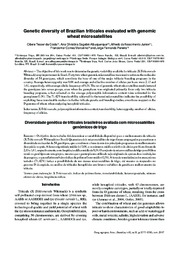Genetic diversity of Brazilian triticales evaluated with genomic wheat microsatellites.
Genetic diversity of Brazilian triticales evaluated with genomic wheat microsatellites.
Author(s): COSTA, C. T. da; ALBUQUERQUE, A. C. S.; NASCIMENTO JUNIOR, A. do; MARCELINO-GUIMARÃES, F. C.; PEREIRA, J. F.
Summary: The objective of this work was to determine the genetic variability available for triticale (X Triticosecale Wittmack) crop improvement in Brazil. Forty-two wheat genomic microsatellites were used to estimate the molecular diversity of 54 genotypes, which constitute the base of one of the major triticale breeding programs in the country. Average heterozygosity was 0.06 and average and effective number of alleles per locus were 2.13 and 1.61, respectively, with average allelic frequency of 0.34. The set of genomic wheat microsatellites used clustered the genotypes into seven groups, even when the germplasm was originated primarily from only two triticale breeding programs, a fact reflected on the average polymorphic information content value estimated for the germplasm (0.36). The 71.42% transferability achieved for the tested microsatellites indicates the possibility of exploiting these transferable markers in further triticale genetic and breeding studies, even those mapped on the D genome of wheat, when analyzing hexaploid triticales.
Publication year: 2007
Types of publication: Journal article
Observation
Some of Embrapa's publications are published as ePub files. To read them, use or download one of the following free software options to your computer or mobile device. Android: Google Play Books; IOS: iBooks; Windows and Linux: Calibre.
Access other publications
Access the Agricultural Research Database (BDPA) to consult Embrapa's full library collection and records.
Visit Embrapa Bookstore to purchase books and other publications sold by Embrapa.

